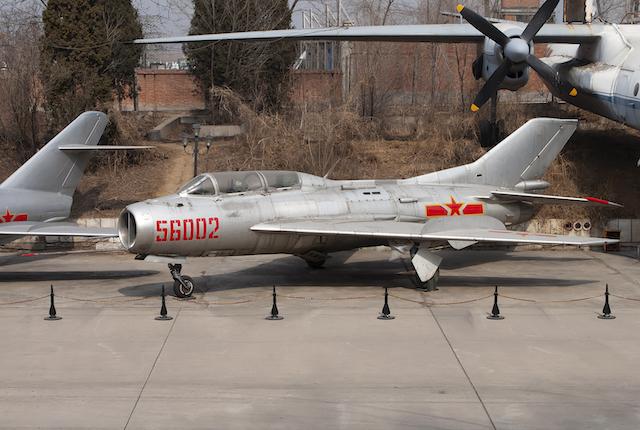The Weekly Debrief: How China May Have Resurrected A 1950s Fighter For A New Combat Role

Shenyang J-6
The heyday of the Shenyang J-6 Farmer – a Chinese copy of the MiG-19, the first mass-produced supersonic fighter – appeared to expire decades ago, as the People’s Liberation Army Air Force (PLAAF) began restocking with hundreds of fourth- and fifth-generation fighters.
But some military analysts now think the J-6 – and contemporaries such as the MiG-21-derived J-7 and the indigenous J-8 and Q-5 fighters – still may play a critical role in a Taiwan conflict, but this time in a theorized role as a cheap, potentially reusable vanguard of uncrewed combat air vehicles (UCAVs).
For several years, the U.S. Air Force has been experimenting and demonstrating different concepts for low-cost, attritable aircraft, ranging from artificial intelligence-piloted Kratos XQ-58 UCAVs to missionized versions of Boeing QF-16 target drones. China, however, arguably invented the concept in the early 1960s, fashioning a “disposable" 100-flight-hour design for the J-6, which would then require a depot maintenance cycle to remain airworthy.
The concept may have reflected the limits of China’s nascent aerospace manufacturing capability in the 1960s and 1970s, but it appears to have come full circle as part of a new warfighting concept that prizes quantity in some cases as much as quality.
The theory that China could use expired, second-generation jet fighters as armed drones has been going around in defense circles for several years, but new research by an analyst at the Mitchell Institute for Aerospace Studies may reveal where and how the PLAAF’s horde of converted UCAVs could be employed in a Taiwan scenario.
Media reports already had identified 32 hardened shelters at three bases on China’s east coast across from Taiwan. In fact, China has constructed another 94 hardened shelters at a total of five bases within range of Taiwan, Daniel Rice, a Mitchell Institute non-resident fellow, writes in a newly published paper. The additional 94 shelters are sized to house as many as three UCAVs each, or up to 294 converted fighters.
In addition to the shelters at all five bases (namely, Longtian, Luocheng/Huian, Shantou, Shuiman and Zhangzhou), satellite imagery indicates significant new infrastructure, including the construction of buried fuel depots and hardened storage facilities, Rice says.
“With the large number of seemingly unused hardened, underground and concealed shelters identified at the airfields, it is possible that the PLAAF could pre-position a variety of UCAVS in operation against Taiwan,” Rice writes.
Requiring less maintenance than crewed fighters, a fleet of hundreds of converted UCAVs can be stored inside the hardened shelters for long periods. In the event of a conflict with Taiwan, the PLAAF can roll them out to execute an initial assault on Taiwan. All five bases lie within the combat radius of the Q-5, J-6, J-7 and J-8.
“UCAVs make it possible for the PLAAF to use relatively cheap, capable, low-risk airframes as a first-in asset to either strike or soften Taiwan’s air defense systems,” Rice says.
Operating reusable UCAVs also may address persistent PLAAF concerns about the risk of pilot defections. “In more recent years, concerns over defections and a lack of trust between PLAAF commanders and pilots may be one of the reasons why incursions into Taiwan’s [air defense identification zone] have occurred only infrequently toward the centerline with Taiwan,” Rice writes.
A strategy of concealment creates operational opportunities. During large-scale exercises in 1996, the PLAAF deployed fighters based elsewhere to front-line bases. After the converted UCAVs complete the initial assault on Taiwan’s air defense, a second wave of crewed fighters could re-occupy the hardened shelters, allowing the PLAAF to carry out sustained attacks with 4.5- and 5th-generation fighters, Rice says, referring to this strategy as the “Cicada concept.”
Counters emerge to any new technology. Hardened shelters can be targeted with penetrating missiles. Runways can be deactivated with well-placed precision munitions. But Rice notes that runways also can be repaired within hours, and defeating 126 hardened shelters may consume a significant portion of Taiwanese or allied missile stocks. Moreover, the Chinese may have constructed other hidden facilities, in addition to the five bases identified by Rice.
“This implies more [U.S.] strike capacity may be needed than is currently planned,” Rice concludes.



Comments
I hope that European and US forces are learning the lessons from the conflict in Ukraine, because future non-nuclear conflicts will be won or lost with this scenario.
Bernard GUILLAUME